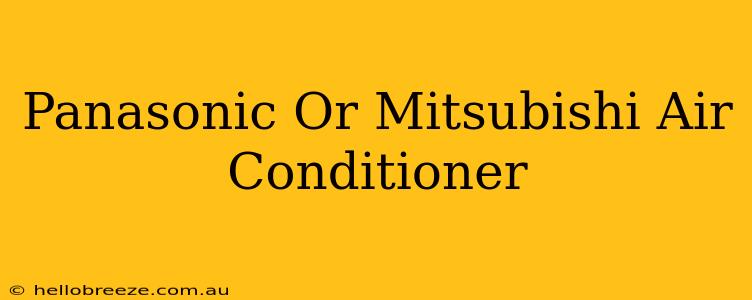Choosing the right air conditioner can significantly impact your comfort and energy bills. Two leading brands often top the list: Panasonic and Mitsubishi. Both offer a range of high-quality units, but understanding their key differences is crucial for making an informed decision. This comprehensive guide will help you weigh the pros and cons of Panasonic and Mitsubishi air conditioners to determine which best suits your needs and budget.
Key Features and Comparisons: Panasonic vs. Mitsubishi
Both Panasonic and Mitsubishi are known for their innovative technology and reliable performance. However, certain features differentiate them:
Panasonic Air Conditioners:
-
Strengths: Panasonic often boasts strong cooling power and energy-efficient models. They are frequently praised for their quiet operation and ease of use. Many Panasonic units incorporate advanced features like nanoe™ technology, which helps improve air quality by suppressing odors and allergens. Their designs often prioritize sleek aesthetics.
-
Weaknesses: Pricing can sometimes be higher than comparable Mitsubishi models. The availability of certain features or models may vary depending on your region.
Mitsubishi Air Conditioners:
-
Strengths: Mitsubishi is renowned for its innovative technology, particularly in the area of inverter technology, which leads to efficient energy consumption and precise temperature control. They often offer a wider range of sizes and styles, catering to various spaces and design preferences. Mitsubishi Electric's Hyper-Heating INVERTER systems are particularly well-regarded for their performance in colder climates.
-
Weaknesses: While generally reliable, some users report occasional higher repair costs compared to Panasonic. Certain advanced features might be found only in higher-end models, driving up the price.
Factors to Consider When Choosing
Several factors should influence your decision beyond brand alone:
-
Budget: Determine your price range upfront. Both brands offer units at various price points, but Mitsubishi's broader range might offer more budget-friendly options.
-
Room Size: Accurate room measurements are critical. Choose a unit with the appropriate BTU (British Thermal Unit) rating for effective cooling.
-
Energy Efficiency: Look for an Energy Star rating. Both Panasonic and Mitsubishi offer energy-efficient models, but compare the SEER (Seasonal Energy Efficiency Ratio) ratings to find the most cost-effective option for your needs.
-
Special Features: Consider features like Wi-Fi connectivity, smart home integration, air purification systems, and quiet operation.
-
Climate: If you live in an area with extreme temperatures, consider models designed for those conditions. Mitsubishi's Hyper-Heating INVERTER systems excel in cold climates.
Maintenance and Longevity
Regular maintenance is crucial for extending the lifespan of any air conditioner. Both Panasonic and Mitsubishi generally offer reliable performance, but proper care, including filter cleaning and occasional professional servicing, will maximize their longevity and efficiency.
Conclusion: Making the Right Choice
Ultimately, the "best" air conditioner depends on your individual needs and preferences. Both Panasonic and Mitsubishi produce high-quality units. By carefully considering the factors outlined above – budget, room size, energy efficiency, special features, and climate – you can confidently select the air conditioner that provides optimal comfort and performance for years to come. Don't hesitate to consult with HVAC professionals for personalized recommendations based on your specific circumstances.

